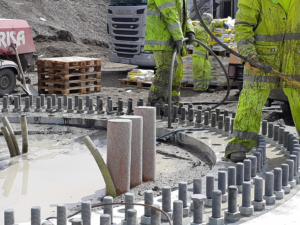Reliable Rock Anchors for Secure and Secure Foundations
In the realm of civil design, the role of reliable rock supports can not be overstated, as they are pivotal in establishing protected and secure foundations throughout a range of applications. These anchors not just promote tons transfer from structures to bedrock yet also give important resistance against all-natural forces, including wind and seismic task. Comprehending the different sorts of rock supports, their details applications, and the ins and outs of installation and maintenance is crucial for enhancing their efficiency. What factors should be taken into consideration when selecting one of the most appropriate anchoring remedy for an offered job?
Types of Rock Anchors

Passive anchors rely upon the weight of the framework and the surrounding soil or rock to supply resistance. They are typically used in applications where very little activity is expected. Active supports, on the various other hand, entail the application of stress via a high-strength cable or rod, producing a pre-stressed problem in the support. This type is specifically useful in vibrant environments, such as landslide-prone areas.
Grouted supports are one more considerable classification, where a steel bar or cord is placed right into a drilled hole, complied with by a cementitious cement. As soon as treated, the cement bonds with the surrounding rock, creating a robust anchoring system. Each kind of rock support supplies distinctive benefits based on the certain geological conditions and structural requirements, thereby playing a crucial role in the total honesty and long life of built centers.
Applications in Building
Rock supports play an essential role in numerous building applications, providing crucial assistance and stability in varied settings. These innovative remedies are used in projects varying from large-scale framework developments to smaller sized domestic structures. One of the key applications of rock anchors remains in the stabilization of inclines and retaining wall surfaces, where they help stop dirt erosion and keep structural honesty.
Additionally, rock supports contribute in protecting foundations for bridges, tunnels, and skyscrapers, ensuring they can stand up to side forces such as wind and seismic task. Their convenience permits installment in challenging geological conditions, making them excellent for projects in hilly or rocky surfaces.

Key Choice Criteria
Choosing the ideal rock anchor for a certain application calls for careful factor to consider of numerous essential requirements. Primarily, the geological problems of the website should be completely assessed. Recognizing rock kind, stamina, and security is essential to guarantee that the support will certainly execute effectively under tons conditions.

An additional important element is the rust resistance of the support products. In atmospheres revealed to dampness or chemicals, using corrosion-resistant materials will extend the life-span of the supports and keep architectural integrity in time.
Furthermore, the anchor's setup technique must line up with the job's needs and restraints. Reduce of installment, along with the potential influence on bordering frameworks, have read to be taken into consideration.
Installment Strategies
Reliable installment strategies are critical for the effective efficiency of rock supports. Appropriate installment makes certain that the supports attain the preferred load-bearing capability and stability within the geological conditions. The initial step in the installment procedure includes website evaluation, where geological surveys identify the rock type, problem, and any kind of prospective obstacles.
Once the website is examined, the proper drilling method should be picked-- options include rotating exploration, ruby exploration, or percussion boring. The selection relies on rock solidity and ecological considerations. Precise boring depth and angle are important to guarantee that the supports line up with structural requirements and load distribution.
After drilling, the next phase involves cleaning up the borehole to eliminate debris, which can jeopardize bond stamina. Following this, the support is put, and if needed, a cement or material is injected to boost bond. The healing time of these materials need to be complied with, making certain that the supports accomplish full toughness prior to any load is applied.
Upkeep and Assessment
Appropriate you can try here maintenance and assessment of rock supports are important to guarantee their long-term efficiency and reliability (Williams Anchors). Normal evaluations help determine any possible issues, such as deterioration, displacement, or structural exhaustion that could jeopardize the stability of the anchoring system
Routine assessments should be performed at defined intervals, taking into consideration ecological variables and the specific application of the rock supports. Aesthetic examinations should concentrate on the exposed sections of the anchors, inspecting wikipedia reference for signs of corrosion, splits, or other anomalies. In addition, it is essential to evaluate the surrounding geological conditions to detect any type of shifts in soil or rock that may impact support efficiency.
In some instances, advanced techniques such as tons screening or non-destructive testing may be called for to determine the supports' load-bearing ability and overall wellness. Proper paperwork of examination findings, maintenance tasks, and any repair work or replacements carried out is essential for ongoing assessment and compliance with sector requirements.
Conclusion
In final thought, dependable rock anchors play a critical duty in making sure protected and secure structures throughout numerous construction applications. By properly transferring tons and boosting security versus lateral forces, these anchors add substantially to the longevity and integrity of structures such as bridges, tunnels, and preserving walls. Strategic selection, installment, and maintenance of rock anchors are necessary for enhancing efficiency and protecting public safety, eventually underscoring their value in contemporary engineering practices.